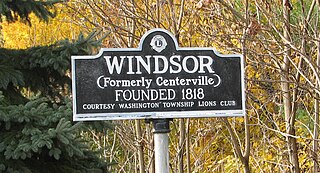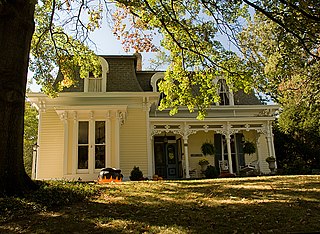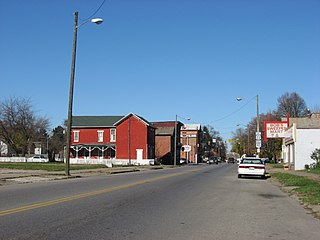
Marietta is a city in, and the county seat of, Washington County, Ohio, United States. It is located in southeastern Ohio at the confluence of the Muskingum and Ohio Rivers, 11 miles (18 km) northeast of Parkersburg, West Virginia. As of the 2020 census, Marietta has a population of 13,385 people. It is the principal city of the Marietta micropolitan area, which includes all of Washington County, and is the second-largest city in the Parkersburg–Marietta–Vienna combined statistical area.
John Todd was an American Congregationalist minister, co-founder of Tabor College in Tabor, Iowa, a leading abolitionist and a conductor on the Underground Railroad.

Providence Forge is an unincorporated community in New Kent County, Virginia, United States. It was one of the earliest settlements in the county and the site of a colonial iron forge that was destroyed by British General Banastre Tarleton during the American Revolutionary War.

Windsor is a small historic unincorporated community and census-designated place (CDP) located within Robbinsville Township in Mercer County, in the U.S. state of New Jersey. The area is served as United States Postal Service ZIP Code 08561. As of the 2020 United States census, the CDP's population was 330, an increase of 104 (+46.0%) above the 226 counted at the 2010 census. The community, covering 570 acres (230 ha), was added to the National Register of Historic Places in 1992.
Africa is an unincorporated community located in Orange Township of southern Delaware County, Ohio, United States, by Alum Creek.

The Josiah Kirby House is a historic residence in the city of Wyoming, Ohio, United States. Erected in the late nineteenth century, it was originally the home of a prominent Cincinnati-area businessman and politician, and it has been designated a historic site.

The Professor William Pabodie House is a historic residence in the city of Wyoming, Ohio, United States. Erected in the late nineteenth century, it was originally the home of a Cincinnati-area educator, and it has been designated a historic site because of its distinctive architecture.

The Daniel Howell Hise House is an historic home that was part of the Underground Railroad. It is listed on the National Register of Historic Places and is located in Salem, Ohio.

Pocahontas Island is a peninsula in Petersburg, Virginia once on the opposite side of the Appomattox River from Petersburg. Since 1915 a new channel for the river separated it from Chesterfield County and the former channel no longer separates it from the city. Once a warehouse and wharf-filled urban landscape initially platted in 1749, the island was devastated by a 1993 tornado before citizen involvement caused creation of the Pocahontas Island Historic District, which in 2006 achieved listing on the National Register of Historic Places (NRHP) as a historic district because of its significance in African-American history and for its prehistoric indigenous archeological assets.

The Underground Railroad in Indiana was part of a larger, unofficial, and loosely-connected network of groups and individuals who aided and facilitated the escape of runaway slaves from the southern United States. The network in Indiana gradually evolved in the 1830s and 1840s, reached its peak during the 1850s, and continued until slavery was abolished throughout the United States at the end of the American Civil War in 1865. It is not known how many fugitive slaves escaped through Indiana on their journey to Michigan and Canada. An unknown number of Indiana's abolitionists, anti-slavery advocates, and people of color, as well as Quakers and other religious groups illegally operated stations along the network. Some of the network's operatives have been identified, including Levi Coffin, the best-known of Indiana's Underground Railroad leaders. In addition to shelter, network agents provided food, guidance, and, in some cases, transportation to aid the runaways.

St. Patrick's Church is an historic Roman Catholic church in Glynwood, an unincorporated community in Moulton Township, Auglaize County, Ohio, United States. Located north of U.S. Route 33 between St. Marys and Wapakoneta, the church was built in 1883 in the Gothic Revival style. It is one of many large Catholic churches in a region of rural western Ohio known as the "Land of the Cross-Tipped Churches," which was settled by primarily Catholic immigrants during the nineteenth century.

Bethel African Methodist Episcopal Church is a historic African Methodist Episcopal Church in Springtown, New Jersey, United States. The church was part of two free negro communities, Othello and Springtown, established by local Quaker families. The congregation was established in 1810 in Greenwich Township as the African Methodist Society and joined the African Methodist Episcopal Church in 1817. A previous church building was burned down in the 1830s in an arson incident and the current structure was built between 1838 and 1841.

The Mechanicsburg Baptist Church is a historic church in the village of Mechanicsburg, Ohio, United States. Constructed for a Methodist congregation in the late nineteenth century, the building was taken over by Baptists after the original occupants vacated it, and it has been named a historic site.

The James and Sophia Clemens Farmstead is a historic farm situated in western Darke County, Ohio, United States. Located at 467 Stingley Road, approximately 1 mile (1.6 km) from the Indiana border, it is among the oldest remaining buildings of a small community of free African-Americans founded before the Civil War.

The Millen House is a historic residence on the campus of Indiana University in Bloomington, Indiana, United States. Built by an early farmer, it is one of Bloomington's oldest houses, and it has been named a historic landmark.

The Hopewell Baptist Church in northwestern Oklahoma County, Oklahoma, also known as the Teepee Church, was designed by architect Bruce Goff in the modernist style. It was listed on the U.S. National Register of Historic Places in 2002. It was deemed "an excellent example of the architecture of Bruce Goff during the time he was Director of the School of Architecture at the University of Oklahoma."

Putnam Historic District, located in Zanesville, Ohio, was an important center of Underground Railroad traffic and it home to a number of abolitionists. The district, with private residences and other key buildings important in the fight against slavery, lies between the Pennsylvania Central Railroad, Van Buren Street, and Muskingum River. It became a historic district of the National Register of Historic Places in 1975.

The Rushville Historic District is a historic district in Richland Township, Fairfield County Ohio which bounds the original village of Rushville. The district is considered both historically and architecturally significant due to the preservation of many houses and commercial buildings representing a period from the 1820s to the early 1900s. It features examples of log construction, Gothic Revival, Federal, Italianate, and Queen Anne style architecture.




















